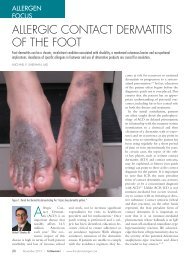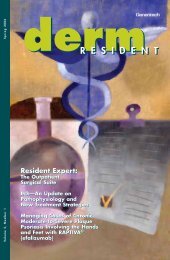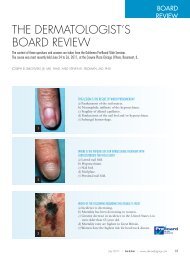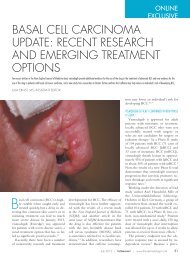Download PDF - The Dermatologist
Download PDF - The Dermatologist
Download PDF - The Dermatologist
You also want an ePaper? Increase the reach of your titles
YUMPU automatically turns print PDFs into web optimized ePapers that Google loves.
Getting Published<br />
tive, and others focus on researchbased<br />
articles.<br />
“While journals are one choice,<br />
the opportunity to present at a national<br />
society meeting or publish a scientific<br />
poster presentation is an ideal option<br />
for some potential authors. <strong>The</strong> first<br />
step is to decide what you have to<br />
communicate and to what audience<br />
and explore the options,” she adds.<br />
Some publishers and organizations<br />
field inquiries about possible future topics<br />
and often publish on their websites<br />
or in their journals a “call for abstracts.”<br />
It is not out of place for a prospective<br />
author to contact a journal, publisher, or<br />
organization and express interest in<br />
developing material on specific content.<br />
If the publisher thinks the material<br />
might be suitable, the author is advised<br />
to develop the idea more formally.<br />
“Preparation, submission, and presentation<br />
of an abstract are important<br />
steps in the research process that can<br />
benefit the investigator/author. <strong>The</strong><br />
abstract typically describes a study and<br />
its results, but the first step in writing<br />
an abstract includes reading the<br />
instructions or guidelines given from<br />
the journal, society, or organization.<br />
First-time authors might find it helpful<br />
to read through published abstracts<br />
from the most recent annual meeting<br />
to help illustrate the concepts discussed<br />
in that article, poster, or presentation<br />
and develop a feel for what a good and<br />
accepted abstract looks like,” says<br />
Moore.<br />
Even scholarly publishers and<br />
meeting planners have to “market”<br />
their materials, so they are looking for<br />
content that is timely, of great interest<br />
to the target audience, and—ideally—<br />
not presented as well or as thoroughly<br />
in other places. Identifying the channels<br />
and their respective target audiences<br />
is an easy but often overlooked<br />
step by new authors.<br />
Most publications have authors’<br />
guidelines, which specify how they wish<br />
to receive materials. Conventions and<br />
society meetings may have regulations—and<br />
deadlines—as to what sort<br />
of materials to submit. Adherence to<br />
these guidelines and their deadlines<br />
greatly enhances the chance that the<br />
material will be published. Publishers—<br />
no matter how interested in a specific<br />
topic—may not be able to work with<br />
material that is submitted past deadline<br />
or not in the proper format.<br />
One general rule in publishing: it<br />
never hurts to ask. Provided queries are<br />
brief and on-point, most publishers<br />
prefer getting them to full-blown<br />
materials that may not be exactly what<br />
they seek. But once an author and a<br />
publisher have established that they<br />
want to work together, a very different<br />
phase of the project commences.<br />
It is not out of<br />
place for a<br />
prospective author<br />
to contact a<br />
journal, publisher,<br />
or organization<br />
and express<br />
interest in<br />
developing<br />
material on<br />
specific content.<br />
PREPARING YOUR MATERIALS<br />
Developing the material can be the<br />
most exciting—or the most bothersome—part<br />
of the project.<br />
“I don’t recommend spending<br />
serious time developing the final manuscript<br />
until it has found a potential<br />
‘home,’” added Moore. “It is wise to<br />
work with the editor to define the<br />
material and be sure there is interest<br />
and a need for the content. Even before<br />
the first word of an article is written, a<br />
good editor is already helping to shape<br />
the final product.”<br />
In terms of writing, most writer’s<br />
guidelines help define the format and<br />
scope of the article. For physicians<br />
comfortable with organizing their<br />
thoughts on paper, writing can go<br />
quickly. Others may rely on assistants,<br />
support staff, or even freelance writers<br />
to produce the material.<br />
“When you write a manuscript or<br />
even construct a presentation, there are<br />
really three phases involved,” Moore<br />
explained. “<strong>The</strong> first is writing, the act<br />
of getting the thoughts down on paper<br />
or typed in the computer. <strong>The</strong> second<br />
phase is gathering resources or<br />
researching your topic, including<br />
obtaining references. Unless your manuscript<br />
is historical in nature, references<br />
that are over 10 years old should be<br />
scrutinized to account for new information<br />
that may have been published.<br />
<strong>The</strong> third phase is editing, which<br />
means going through that material<br />
meticulously to make sure it has good<br />
structure, inherent logic, and clarity.<br />
Rarely is anybody good at both writing<br />
and editing, so don’t be afraid to go<br />
to a peer or professional for his or her<br />
opinion prior to submission.Try not to<br />
be afraid of criticism or suggestions<br />
that might enhance your manuscript.<br />
Most of us—even professionals in publishing—tend<br />
to be either more in the<br />
writing camp or more in the editing<br />
camp. Find out which strength is yours<br />
and get help with the other part.”<br />
For some physician-authors, this<br />
may mean submitting data, notes, and<br />
ideas to a ghostwriter to get the first<br />
draft put together. For other physicianauthors,<br />
it may mean contracting with<br />
a freelance editor to review the article<br />
and suggest ways to improve it. Most<br />
journals offer editorial support as well,<br />
but the more finalized material is when<br />
it arrives at the journal, the better the<br />
chance it will get printed. “It can be<br />
very competitive out there,” Moore<br />
remarked. “Journals are extending the<br />
amount of review time for manuscripts,<br />
and editors are more inclined to<br />
favor finalized material over manuscripts<br />
that they have to help organize<br />
or create. Use spell-check, follow the<br />
instructions or guidelines for authors,<br />
and organize your thoughts within the<br />
manuscript.”<br />
Illustrations can be a crucial component<br />
in creating a powerful publication,<br />
but few dermatologists have the<br />
skills necessary to produce professional-level<br />
art work.<br />
“Most publishers know this and<br />
have access to artists who can develop<br />
charts, graphs, diagrams, and drawings.<br />
<strong>The</strong>re are also agencies or freelance<br />
designers or artists who can help doctors<br />
develop animations for presentations,”<br />
Moore stated.“When a publish-<br />
PAGE 5
















